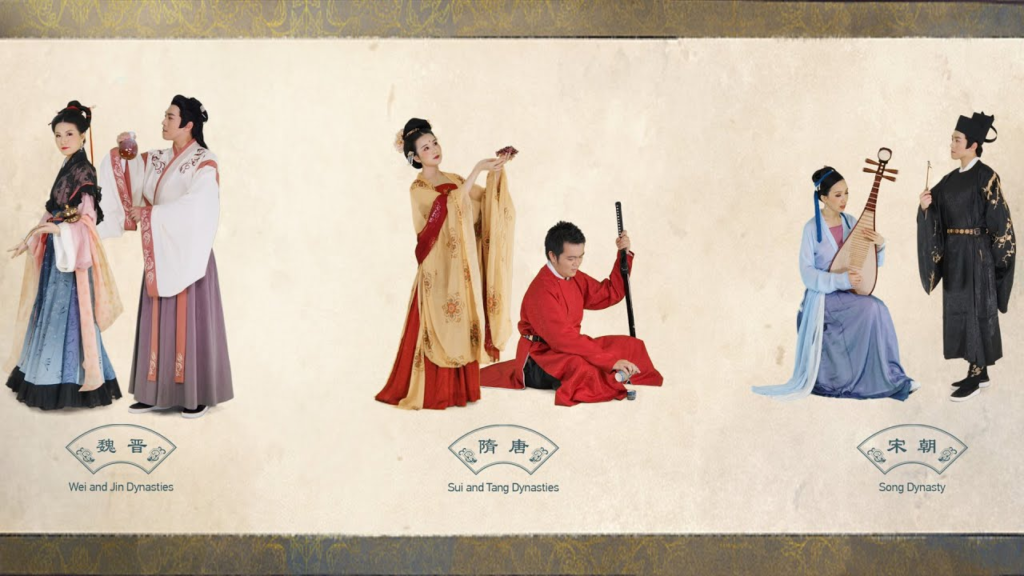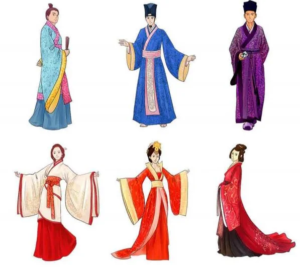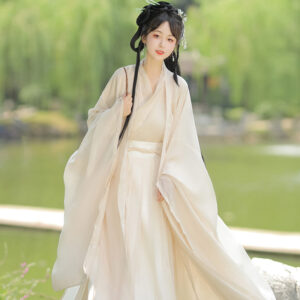

During the Song Dynasty (960–1279 CE), Hanfu underwent significant changes influenced by political, cultural, and philosophical shifts in Chinese society. The Song Dynasty marked a period of revival for Confucian values, which greatly impacted clothing, especially in terms of ceremonial and formal attire. This revival was part of a broader movement known as Neo-Confucianism, which emphasized order, propriety, and social hierarchy. Here’s a detailed look at how Hanfu evolved during this period:
1. Emphasis on Simplicity and Elegance
Unlike the extravagant styles of the Tang Dynasty, Song Dynasty Hanfu reflected a return to simplicity and elegance. Song fashion was more conservative, with less focus on flamboyant colors or highly decorated fabrics. Instead, garments were often characterized by soft, flowing lines and more restrained patterns, showcasing the Confucian ideals of modesty and discipline.
For both men and women, the focus shifted towards functionality, elegance, and scholarly refinement. The Shenyi, a long, flowing robe, remained a staple during the Song period but became more standardized, with clearer guidelines on appropriate occasions for its use.
2. Revival of Confucian Ritual Dress
One of the most important changes during the Song Dynasty was the revival of traditional Confucian ritual clothing, particularly for important state ceremonies and ancestral worship. The Xuanduan, a black upper garment with a red lower skirt, became the standard attire for these rituals. This combination of black and red symbolized the cosmic duality of Heaven and Earth, a concept central to Confucian thought.
The Xuanduan was worn by officials, scholars, and common people during formal religious events or rituals, further emphasizing the societal order and respect for Confucian values. The Song government placed great importance on ritual propriety, and this was reflected in how people dressed for religious or official events.
3. Influence of Neo-Confucianism
Neo-Confucianism, a philosophical movement that rose during the Song period, had a profound impact on clothing. It advocated for a disciplined, moral life, which extended to fashion choices. Clothing was expected to reflect one’s ethical character. This led to a preference for simple, dignified garments that adhered to social norms and respected traditional values.
Neo-Confucian scholars also influenced the designs of Hanfu, particularly in the context of official dress. For example, court attire became more refined and less ostentatious, focusing on practicality and adherence to societal rank and duties. Scholars and officials wore robes that were more formal but lacked excessive decoration, embodying the Neo-Confucian ideals of inner virtue over outer appearance.
4. Introduction of Lightweight Fabrics
The Song Dynasty saw advances in textile production, leading to the widespread use of lighter fabrics like silk gauze and cotton. These materials allowed for greater comfort and flexibility, especially in the hot and humid climate of southern China. The introduction of these lighter fabrics contributed to the fluidity and grace of Song Dynasty Hanfu, which was noted for its understated beauty.
Clothing became less bulky, and the materials were more suited for daily wear, although ceremonial Hanfu retained a more formal and structured appearance.
5. Differences Between Social Classes
The Song Dynasty was known for its burgeoning urban economy, with merchants and artisans becoming wealthier, resulting in greater social mobility. However, the government enforced strict dress codes to maintain distinctions between social classes. The upper class and government officials were allowed to wear silk and other luxurious materials, while commoners were restricted to simpler fabrics like hemp or cotton.
High-ranking officials and scholars were distinguished by the style and quality of their robes, often featuring wide sleeves and embroidered symbols that denoted their rank. These distinctions helped reinforce the social hierarchy, which was a key tenet of Confucianism during this era.
6. Women’s Fashion in the Song Dynasty
Women’s Hanfu in the Song Dynasty evolved to reflect the Confucian ideals of modesty and virtue. Unlike the more flamboyant and revealing styles of the Tang period, Song Dynasty women’s fashion became more conservative. Women wore long skirts (qun) paired with long-sleeved blouses (ru) that often had a high collar.
However, even within these conservative styles, Song women’s Hanfu maintained a delicate, graceful aesthetic. Loose, flowing skirts and light, layered fabrics contributed to a look that was both demure and elegant. Women of higher status would wear embroidered patterns on their garments, though still within the bounds of modesty.
In some cases, Song women wore a beizi, a long coat-like outer garment with wide sleeves that extended past the knees. The beizi became one of the most iconic garments of the Song Dynasty for women, reflecting the layered, modest style of the period.
7. Impact of the Scholar-Bureaucrat Class
During the Song Dynasty, the scholar-bureaucrat class, or shi, rose to prominence due to the imperial examination system, which was based on Confucian teachings. These scholar-officials became influential in shaping fashion, especially in terms of formal dress. Their Hanfu, typically understated and formal, reflected their dedication to Confucian ideals of governance, learning, and morality.
Scholar-officials often wore round-collared robes that were simple yet dignified. These garments conveyed a sense of scholarly respectability and were symbolic of their intellectual and moral superiority. The rise of this class reinforced the link between clothing and societal status during the Song Dynasty.
8. Court and Military Hanfu
While the overall trend in Song Dynasty Hanfu was towards simplicity, court and military Hanfu were more elaborate to reflect the wearer’s status and role. Court officials wore long robes with large sleeves and intricate patterns, while military officials had more practical attire with tighter sleeves and stronger materials suited for their role.
Military Hanfu, though functional, was often adorned with symbols of power such as tigers or dragons, denoting bravery and authority. These uniforms were designed to command respect while allowing for movement and protection in battle.
9. Influence of Foreign Cultures
Although the Song Dynasty was relatively isolated compared to other periods of Chinese history, it still experienced cultural exchanges, especially through trade with neighboring regions like the Liao and Jin dynasties, as well as the Tangut and Western Xia kingdoms. This led to minor influences from these cultures in the details of Hanfu, though the core Confucian ideals remained dominant.
For instance, some Song Dynasty Hanfu incorporated design elements like fur-lined collars or jackets that were adapted from northern peoples. These influences, however, were mostly limited to casual wear and did not significantly affect ceremonial or formal clothing.
10. Legacy of Song Dynasty Hanfu
The legacy of Hanfu during the Song Dynasty is significant in shaping Chinese clothing in later periods. The Song emphasis on Confucian values, simplicity, and modesty influenced the evolution of Hanfu in subsequent dynasties like the Ming. In modern times, the revival of Hanfu often draws on the Song Dynasty’s elegant, refined styles as a symbol of cultural pride and Confucian heritage.
Song Dynasty Hanfu, with its balance between functionality and aesthetic beauty, continues to be celebrated for its contribution to Chinese fashion history. The scholarly elegance and graceful simplicity of this period remain iconic in the evolution of Hanfu.
Share this post
Recent Posts


What were the key features of Hanfu during the Tang Dynasty?

How did Hanfu styles vary during different Chinese dynasties?

What accessories are typically worn with Hanfu?

How do you choose the right Hanfu for different seasons?

Newsletter
Popular Categories
Related Post
Sed aliquam, tortor et sodales malesuada, lorem leo luctus tellus, quis interdum eros nibh in nunc. Cras dignissim malesuada, lorem leo luctus

What are the winter hanfu called?

What were the key features of Hanfu during the Tang Dynasty?

How did Hanfu styles vary during different Chinese dynasties?


